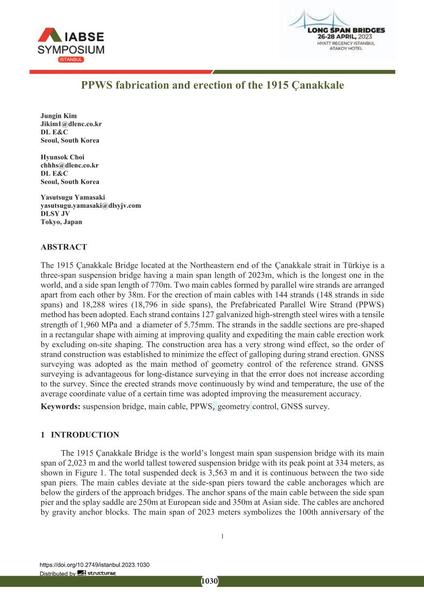PPWS fabrication and erection of the 1915 Çanakkale

|
|
|||||||||||
Détails bibliographiques
| Auteur(s): |
Jungin Kim
(DL E&C, Seoul, South Korea)
Hyunsok Choi (DL E&C, Seoul, South Korea) Yasutsugu Yamasaki (DLSY JV, Tokyo, Japan) |
||||
|---|---|---|---|---|---|
| Médium: | papier de conférence | ||||
| Langue(s): | anglais | ||||
| Conférence: | IABSE Symposium: Long Span Bridges, Istanbul, Turkey, 26-28 April 2023 | ||||
| Publié dans: | IABSE Symposium Istanbul 2023 | ||||
|
|||||
| Page(s): | 1030-1037 | ||||
| Nombre total de pages (du PDF): | 8 | ||||
| Année: | 2023 | ||||
| DOI: | 10.2749/istanbul.2023.1030 | ||||
| Abstrait: |
The 1915 Çanakkale Bridge located at the Northeastern end of the Çanakkale strait in Türkiye is a three-span suspension bridge having a main span length of 2023m, which is the longest one in the world, and a side span length of 770m. Two main cables formed by parallel wire strands are arranged apart from each other by 38m. For the erection of main cables with 144 strands (148 strands in side spans) and 18,288 wires (18,796 in side spans), the Prefabricated Parallel Wire Strand (PPWS) method has been adopted. Each strand contains 127 galvanized high-strength steel wires with a tensile strength of 1,960 MPa and a diameter of 5.75mm. The strands in the saddle sections are pre-shaped in a rectangular shape with aiming at improving quality and expediting the main cable erection work by excluding on-site shaping. The construction area has a very strong wind effect, so the order of strand construction was established to minimize the effect of galloping during strand erection. GNSS surveying was adopted as the main method of geometry control of the reference strand. GNSS surveying is advantageous for long-distance surveying in that the error does not increase according to the survey. Since the erected strands move continuously by wind and temperature, the use of the average coordinate value of a certain time was adopted improving the measurement accuracy. |
||||
| Mots-clé: |
pont suspendu
|
||||
